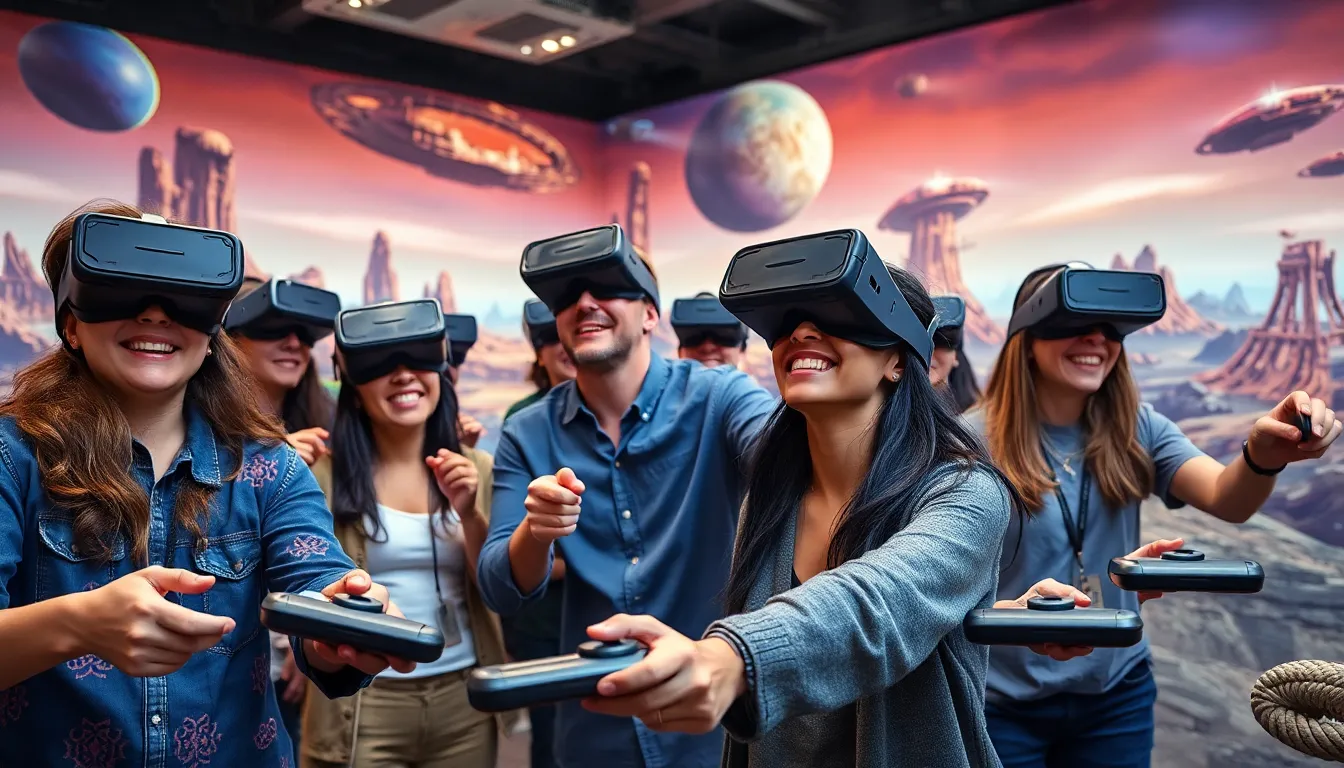Imagine slipping on a headset and suddenly finding yourself in a world where reality takes a backseat. Welcome to the realm of VR escape, where the mundane transforms into the extraordinary. Whether it’s battling aliens in outer space or solving mysteries in a haunted mansion, the thrill of virtual reality offers an escape like no other.
Table of Contents
ToggleOverview of VR Escape
VR escape experiences immerse users in captivating environments that go beyond the confines of reality. These activities often blend elements of gaming and adventure, offering the thrill of exploration and interaction. By donning a VR headset, participants find themselves in intricate worlds where they can engage in challenges, puzzles, or combat scenarios that test their skills.
Users encounter a variety of themes in VR escape settings, such as horror, sci-fi, or fantasy. Each theme provides distinct narratives that enhance the overall experience. Players might navigate haunted houses, unravel conspiracy mysteries, or embark on intergalactic missions. Each session promotes teamwork and problem-solving, making it a cooperative endeavor.
While partaking in VR escape activities, engagement levels elevate significantly. The advanced technology creates realistic graphics, sound effects, and haptic feedback that trigger emotional responses. As players immerse themselves, they experience adrenaline and excitement usually reserved for high-energy scenarios.
Statistics reveal that the VR escape market has grown rapidly, projected to exceed a value of $300 million by 2025. Many participants report high satisfaction rates, with approximately 90% expressing a desire to return for further adventures. These metrics underscore the demand for virtual experiences in entertainment.
When considering accessibility, VR escape rooms cater to diverse audiences. Many venues provide options for varying skill levels, ensuring everyone can participate regardless of previous experience. People seeking novel entertainment find VR escape rooms particularly appealing, as they offer a unique diversion from conventional activities.
Features of VR Escape

VR escape experiences offer a unique blend of adventure, teamwork, and immersive play. Engaging with these features enhances participants’ enjoyment and interaction.
Gameplay Mechanics
Gameplay mechanics in VR escape rooms focus on a mix of challenge and collaboration. Players encounter puzzles that require critical thinking and creativity. Teams often face timed challenges, increasing urgency and excitement. Engaging with character roles adds depth to the experience, allowing participants to immerse themselves in narratives. Players may also navigate obstacles using intuitive controls, which improves user interaction. Dynamic scoring systems track performance, motivating teams to compete and achieve higher scores. These mechanics create a fun, competitive atmosphere that enhances overall enjoyment.
Immersive Environments
Immersive environments captivate players by transporting them to vivid worlds. Visual fidelity and realistic sound design create an authentic atmosphere. Participants often find themselves in fantastical settings, such as alien landscapes or haunted houses. Each location features detailed graphics, enhancing user engagement. Interactive elements enable players to explore their surroundings further, deepening immersion. Participants frequently report feeling emotionally connected to the environment, heightening their overall experience. This combination of sensory stimulation and exploration makes VR escape rooms truly unforgettable.
Benefits of VR Escape
VR escape provides multiple advantages, enhancing both cognitive and social abilities through engaging experiences.
Enhancing Problem-Solving Skills
Engaging in VR escape challenges players with intricate puzzles that require critical thinking. These immersive scenarios encourage collaboration, where team members brainstorm solutions together. Participants navigate through obstacles, developing skills to analyze information quickly. Each completed challenge fosters a sense of accomplishment, enhancing overall confidence. Additionally, the timed nature of many escape scenarios adds pressure, simulating real-world problem-solving situations. Players learn to adapt strategies based on their experiences, resulting in improved decision-making abilities.
Social Interaction Opportunities
VR escape rooms facilitate social connections through shared experiences. Players often join friends, family, or even strangers, promoting teamwork and communication. Interacting within a virtual realm encourages bonding, as participants strategize and celebrate successes together. Many players report stronger relationships formed during these collaborative adventures. The shared thrill of overcoming obstacles contributes to a sense of community. These social aspects enhance enjoyment and encourage players to return for more shared experiences in the future.
Challenges in VR Escape
Challenges exist in the realm of VR escape, influencing user experiences and participation.
Technical Limitations
Technical limitations affect the quality of immersion in VR escape environments. Hardware constraints can lead to subpar graphics, reducing the realism crucial for engagement. Frame rate drops often detract from fluid movement. Latency issues create delays between user actions and system responses, thus hindering gameplay. Some users experience motion sickness due to inadequate comfort settings, making VR escape rooms less enjoyable. Maintaining consistent internet connectivity remains essential for online multiplayer experiences, where a weak connection can disrupt gameplay. Developers continuously work on enhancing software and hardware to reduce these limitations, ensuring participants enjoy seamless, immersive fun.
Accessibility Issues
Accessibility issues challenge inclusivity within VR escape rooms. Not all users can easily use VR headsets due to physical limitations. Some participants may struggle with controlling devices or navigating physical spaces. Affordability also plays a role, as high-end VR setups often come with significant costs, limiting who can experience these adventures. Language barriers create obstacles, particularly in diverse groups where puzzles might use complex vocabulary. Developers aim to create adaptive features to accommodate various needs, helping promote an inviting atmosphere for all players. By addressing these accessibility issues, the VR escape industry can expand its audience and enhance overall participation.
Future of VR Escape
Emerging trends suggest VR escape experiences will evolve significantly in the coming years. Innovations in hardware make immersive worlds more accessible, improving overall user experience. Enhanced graphics engines and advanced haptic feedback will create lifelike environments that captivate players.
Participants are likely to encounter more personalized adventures as artificial intelligence adapts narratives and challenges. This will facilitate unique storylines, ensuring that no two experiences feel the same. Social interactions will also expand, as multiplayer modes embrace larger groups, fostering stronger teamwork dynamics.
Further growth in VR escape rooms is anticipated, aiming for a market value exceeding $300 million by 2025. As consumer interest surges, developers will prioritize creating engaging and diverse themes to match various preferences. This diversification may include new genres like educational and therapeutic experiences.
Inclusivity remains a focus for developers. By integrating adaptive technologies, VR escape experiences can cater to a broader audience, including users with mobility challenges. Addressing affordability will also play a crucial role in expanding participation rates.
Market trends indicate that around 90% of participants express a desire to return for more adventures. This enthusiastic feedback will drive ongoing innovations. Statistically, the demand for immersive experiences continues to grow, forming a prominent aspect of the entertainment industry.
As these changes unfold, the future of VR escape promises to bring enhancements that bridge technology and creativity, resulting in unforgettable adventures.
VR escape experiences are revolutionizing the way people engage with entertainment. By blending adventure and teamwork in immersive environments, they offer a unique escape from reality that captivates users of all ages. The growth of this market reflects a rising demand for innovative and accessible experiences that challenge cognitive and social skills.
As technology continues to evolve, the future of VR escape looks promising. Enhanced graphics and adaptive narratives will create even more engaging adventures. With a focus on inclusivity and affordability, these experiences are set to reach a broader audience, ensuring that more people can enjoy the thrill of virtual exploration. The journey into these captivating worlds is just beginning, and the excitement is bound to grow.


